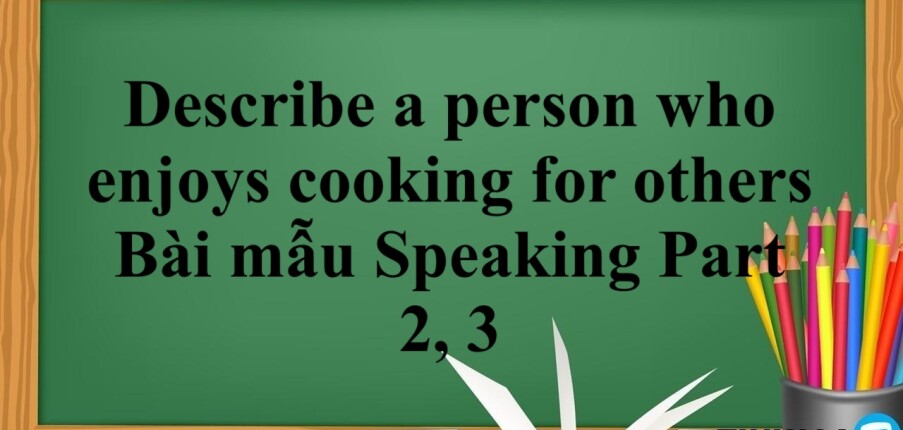Describe a person who enjoys cooking for others | Bài mẫu Speaking Part 2, 3
Bài mẫu “Describe a person who enjoys cooking for others”
Đề bài
You should say:
- who this person is and how you know him/her
- what he/she likes to cook
- who he/she cooks for
And explain why he/she enjoys cooking.
Dàn ý
Situation - I'd like to talk about a friend of mine, Sarah, who has a true passion for cooking and derives immense joy from preparing delicious meals for others.
Task - Describe who Sarah is, explain our connection, highlight her culinary preferences, discuss the recipients of her culinary creations, and explore the reasons behind her love for cooking for others..
Action - Begin by introducing Sarah and our friendship, describe the types of dishes she enjoys preparing, mention the lucky individuals who get to savor her meals, and delve into her motivations and the satisfaction she derives from this act of generosity.
Result - Conclude by emphasizing how Sarah's culinary skills have not only made her friends and family happy but have also created lasting bonds through shared meals.
Bài mẫu
Well, one person who I greatly admire for her culinary skills and her enthusiasm for cooking for others is my friend, Sarah. Sarah and I have been close friends for many years, and I have had the pleasure of experiencing her culinary talents firsthand.
What sets Sarah apart is her diverse repertoire of dishes. She enjoys preparing a wide range of cuisines, from Italian pasta dishes to spicy Thai curries and even elaborate desserts like chocolate soufflés. Her love for experimenting with different flavors and techniques truly shines through in her cooking.
Sarah doesn't limit her culinary delights to just family dinners; she actively seeks opportunities to cook for others. Whether it's hosting a dinner party for friends or bringing homemade treats to the office, she finds immense joy in sharing her creations. It's not just about the food for her; it's about creating memorable experiences through shared meals.
I believe Sarah's enjoyment of cooking for others stems from her belief that food has the power to bring people together. She sees cooking as a way to express love and care for those around her. It's her means of nurturing and connecting with people on a deeper level. Seeing the smiles on people's faces as they savor her dishes is what motivates her to continue cooking with passion.
In conclusion, Sarah is not just a skilled cook; she's a person who genuinely enjoys cooking for others and creating moments of warmth and togetherness through her culinary creations. Her dedication to bringing joy to others through food is truly inspiring.
Từ vựng cần lưu ý
- Culinary skills (Kỹ năng nấu nướng): Kỹ năng và kiến thức liên quan đến nấu ăn.
- Enthusiasm for (Sự hăng hái với): Sự đam mê đối với.
- Culinary preferences (Sở thích ẩm thực): Loại thức ăn và món ăn mà người nào đó ưa thích.
- Culinary talents (Tài năng ẩm thực): Khả năng bẩm sinh hoặc học được liên quan đến nấu nướng.
- Diverse repertoire (Danh mục đa dạng): Một loạt các kỹ năng, khả năng hoặc lựa chọn đa dạng.
- Experimenting with different flavors (Thử nghiệm với các hương vị khác nhau): Thử nghiệm các hương vị và sự kết hợp khác nhau.
- Bringing homemade treats (Mang đồ ăn tự làm): Chia sẻ các món ăn hoặc bữa ăn tự làm.
- Nurturing and connecting (Nuôi dưỡng và kết nối): Chăm sóc và tạo ra mối kết nối tinh thần với người khác.
IELTS Speaking Part 3 Sample – Cooking and Dishes
1. What do we need to prepare when we need to cook?
So, when you're gearing up to cook something tasty, you gotta get a few things sorted. First up, you need the ingredients, and make sure they're fresh and top-notch. Then, grab your kitchen gear – you know, the pots, pans, knives, and all that jazz. Lastly, have a good recipe or at least a plan in mind to keep things on track.
Example: To bake a delicious cake, you'll need ingredients like flour, sugar, eggs, and butter. (Để nướng một chiếc bánh ngon, bạn cần nguyên liệu như bột, đường, trứng và bơ.)
- Top-notch: Xuất sắc, tốt nhất
Example: The restaurant is known for its top-notch service and exquisite cuisine. (Nhà hàng nổi tiếng với dịch vụ xuất sắc và món ăn bắt mắt.)
- Kitchen gear: Dụng cụ nhà bếp
Example: Having the right kitchen gear, including high-quality knives and cookware, makes cooking a lot easier and more enjoyable. (Có đủ dụng cụ nhà bếp, bao gồm dao và nồi chất lượng cao, giúp việc nấu ăn dễ dàng hơn và thú vị hơn.
2. Do you agree that food is an important part of Vietnamese festivals and ceremonies?
Oh, food is a major player at Vietnamese festivals and ceremonies. It's like the heartbeat of the whole celebration. Think of it as a way to connect, bond, and honor traditions. Those traditional dishes, they're not just food; they're storytellers, preserving our culture and bringing families and friends together around the table.
- Honor traditions: Tôn vinh truyền thống
Example: During the holiday season, many families honor traditions by decorating their homes and exchanging gifts. (Trong mùa lễ, nhiều gia đình tôn vinh truyền thống bằng cách trang trí nhà cửa và trao đổi quà.)
- Preserving our culture: Bảo tồn văn hóa của chúng ta
Example: Museums play a crucial role in preserving our culture by showcasing historical artifacts and artworks. (Bảo tàng đóng vai trò quan trọng trong việc bảo tồn văn hóa của chúng ta bằng cách trưng bày các hiện vật và tác phẩm nghệ thuật lịch sử.)
- Bringing families and friends together: Kết nối gia đình và bạn bè
Example: Thanksgiving dinner is known for bringing families and friends together for a festive meal. (Bữa tối Lễ tạ ơn được biết đến là dịp để gia đình và bạn bè quây quần bên nhau trong một bữa ăn lễ hội.)
3. Which dishes are a must at festivals in Vietnam?
When you're talking about Vietnamese festivals, you can't skip over the classics. "Bánh chưng" and "bánh tét" are like the rock stars of the festival menu. They've got that authentic, time-tested flavor that everybody craves. And then there's the irresistible "nem" (spring rolls). They're the life of the party – crispy, flavorful, and impossible to resist.
- Time-tested: Được kiểm nghiệm qua thời gian
Example: This herbal remedy has been time-tested and proven effective in treating common ailments. (Biện pháp chữa bệnh bằng thảo dược này đã được kiểm nghiệm qua thời gian và được chứng minh hiệu quả trong việc điều trị các bệnh thông thường.)
- Craves: Khao khát, mong muốn mạnh mẽ
Example: After a long day of hiking, I often crave a cold, refreshing drink. (Sau một ngày dài leo núi, tôi thường khao khát một ly đồ uống mát lạnh, sảng khoái.)
- Irresistible: Không thể cưỡng lại
Example: The aroma of freshly baked bread is irresistible. (Mùi thơm của bánh mì mới nướng thật khó cưỡng.)
4. Should students learn to cook at school?
Teaching cooking in schools is more than just whipping up meals; it's a life skill that can come in super handy. Imagine knowing how to create delicious, healthy dishes when you're on your own. It's not just about the food; it's about self-sufficiency and making good choices. Plus, it can be a whole lot of fun experimenting in the kitchen.
- A life skill: Kỹ năng sống
Example: Learning how to manage finances is an important life skill that can help individuals achieve financial stability. (Học cách quản lý tài chính là một kỹ năng sống quan trọng có thể giúp cá nhân đạt được sự ổn định tài chính.)
- Come in super handy: Rất hữu ích
Example: Having a basic knowledge of first aid can come in super handy in emergencies. (Hiểu biết cơ bản về sơ cứu có thể rất hữu ích trong trường hợp khẩn cấp.)
5. Do you think cooking should be a compulsory or an elective course? Why?
Well, I reckon it should be a choice. Let students decide if they wanna dive into the cooking world. But hey, maybe a basic cooking class for everyone wouldn't hurt either. It's a life skill, after all.
Example: I reckon it's going to rain later, so you might want to bring an umbrella. (Tôi nghĩ rằng sẽ chút nữa có mưa sau, nên bạn có thể muốn mang theo một chiếc ô đấy.)
- Dive into: Đắm chìm vào, bắt đầu học hoặc tham gia một cách nghiêm túc
Example: She decided to dive into learning a new language and enrolled in a course. (Cô ấy quyết định bắt đầu học một ngôn ngữ mới một cách nghiêm túc và đã đăng ký một khoá học.)
6. Are there any differences between cooking today and in the past?
Indeed, there are notable differences between cooking today and in the past. The introduction of modern kitchen appliances and technology has streamlined cooking processes, making it more convenient and efficient. Additionally, globalization has led to greater culinary diversity, with access to ingredients and recipes from around the world. However, some individuals still value and practice traditional cooking methods as a way to preserve cultural heritage and connect with the past.
- Culinary diversity: Sự đa dạng về ẩm thực
Example: Living in a multicultural city provides the opportunity to experience culinary diversity, with restaurants offering dishes from various parts of the world. (Sống trong một thành phố đa văn hóa mang đến cơ hội trải nghiệm sự đa dạng về ẩm thực, với các nhà hàng phục vụ các món ăn từ nhiều nơi trên thế giới.)
- Preserve cultural heritage: Bảo tồn di sản văn hóa
Example: Traditional dance performances are a way to preserve cultural heritage and pass down traditions to future generations. (Biểu diễn múa truyền thống là một cách để bảo tồn di sản văn hóa và truyền lại truyền thống cho thế hệ tương lai.)
Xem thêm các tài liệu Tiếng Anh hay, chi tiết khác:
TOP Việc làm "HOT" dành cho sinh viên:




